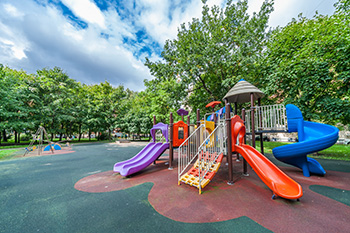Ensure playground safety to protect children

As the sun shines brighter and the weather warms up, children flock to playgrounds for outdoor fun. But beyond playtime, our critical responsibility is ensuring playground safety. National Playground Safety Week, observed annually in April, serves as a timely reminder for youth serving organizations, providers, parents, and communities to prioritize safety and prevent injuries. This article specifically addresses thermal-related burns, a critical concern often overlooked during warmer months.
Playground accidents send over 200,000 children to U.S. emergency rooms each year.1 Of the reported playground injuries involving thermal burns from 2001 to 2008, 48% involved playground surfacing materials.2 While reported numbers weren’t excessive, over 1,200 emergency room visits occurred from 2009 to 2014 involving thermal or unspecified burns associated with playground equipment, with many cases unreported.3
While we often focus on visible hazards like sharp edges, broken equipment, and adequate surface material, this is an excellent opportunity to raise awareness on thermal burns. As organizations dedicated to serving youth, protecting children from playground injuries is of utmost importance.
Hidden Playground Danger: Thermal Burns
Thermal burns occur when a child’s skin contacts hot surfaces. Traditionally, we associate this risk with metal equipment such as slides that could scorch our legs on a sweltering summer day. However, modern playgrounds use a variety of materials, including plastics and rubbers, which can also become scalding hot. Even on mild days, prolonged exposure to direct sunlight can turn play structures and playground surfaces into potential burn hazards and cause severe injuries.
Understanding the Risk
Materials Matter: Plastic, rubber, and other non-metal surfaces can cause thermal burns. Coated or heat-reducing painted metal equipment does not eliminate the risk entirely.
Barefoot Risks: Playground surfacing can cause severe burns. Several incidents have occurred with barefoot children running across playgrounds.
Weather Impact: Contrary to widespread belief, the weather does not need to be scorching for equipment to heat up. According to the U.S. Consumer Product Safety Commission, a 74° day led to a report of serious second-degree burns from a plastic slide.4
Common Culprits:
- Uncoated Metal Equipment: Bare metal surfaces or worn-off heat-reducing coatings.
- Slides and Swings: Areas where children sit or touch.
- Dark-Colored Plastics and Rubbers: Especially the surfacing under and around playground equipment.
- Asphalt and Concrete Surfaces: Near playgrounds.
Climate/Environmental Factors: The risk of thermal burns varies significantly based on geographic location. Changing climates and environmental factors in recent times have heightened awareness of these potential dangers.
Who’s Most Vulnerable?
Children are more vulnerable to burns from hot surfaces than adults for two reasons:5
- Delicate Skin: A young child’s skin is thinner and more susceptible to burning.
- Lack of Reaction: Young children have not yet learned the reaction of moving away from hot surfaces. Unlike the reflex adults have when touching something hot, a young child sitting or standing on a heated surface may scream from pain but not instinctively move away.
Preventing Thermal Burns
Stay Sun-Savvy:
- Be aware of weather conditions. Even on cooler days, direct sunlight can heat up equipment.
- Plan outdoor play during cooler hours, such as early morning or late afternoon, and avoid peak sun exposure, typically between 10 a.m. and 2 p.m. Recognize signs of heat illnesses.
Advocate for Shade:
- Encourage shaded play areas.
- Consider using shade structures to reduce sun exposure.
Test Before Play:
- Always check equipment and surface temperatures before letting children play. Some materials retain heat longer, so a quick touch may not reveal the danger. If equipment feels hot to your hand, it is too hot for a child’s bare skin.
- Regularly check surfaces for excessive heat.
Proper Attire
- Ensure children dress in appropriate clothing. Less exposed skin presents fewer burn risk.
- Footwear should always be worn, regardless of surface material.
Educate and Empower:
- Train caregivers on the hazards of hot surfaces within playgrounds and safe ways to prevent burn injuries.
- Teach kids to recognize hot surfaces and move away if they feel too warm.
Supervise Children Closely:
- Depending on the playground, supervisors may include childcare professionals, volunteers, seasonal staff, or parents.
- Maintain proper staff-to-child ratios and always monitor children.
- Closer supervision is essential during increased hazards, which may require intentional duty shifts, physical positioning adjustments, or additional staffing.
- Children should never be left unattended or alone to engage in unsafe behavior.
Surface Selection
- Choose heat-resistant materials.
Regular Inspections:
- Inspect playgrounds frequently and report any observed hazards promptly to ensure timely repairs.
- Document safety inspections and maintenance on the equipment and surrounding environment
Emergency Preparedness:
- Familiarize yourself with first aid procedures to promptly address minor burns.
- Report all incidents promptly for proper action.
Remember, metal slides are not the only hazardous surface—thermal burns can happen anywhere. Keep playgrounds cool, safe, and enjoyable for every child! By focusing on prevention, education, and vigilance, we can create playgrounds that are not only fun but also a safer environment for our children.
Additional Playground Safety Resources: Prioritizing safety through proper inspection and hazard recognition can create a safe environment for children and significantly reduce playground-related injuries and deaths. Playground Safety Week is an opportunity to raise awareness about all aspects of playground safety.
1 https://www.cpsc.gov/s3fs-public/325.pdf
2 https://www.cpsc.gov/s3fs-public/pdfs/playground.pdf
3 https://www.cpsc.gov/s3fs-public/Injuries%20and%20Investigated%20Deaths%20Associated%20with%20Playground%20Equipment%202009%20to%202014_1.pdf
4 https://www.cpsc.gov/s3fs-public/3200.pdf
5 https://www.cdc.gov/childrenindisasters/features/children-public-health.html
